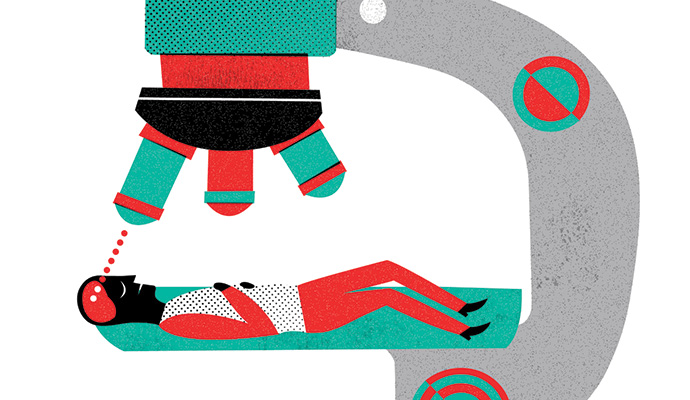How to engage men in corporate wellness programs
Communicating the link between health and workplace performance may help close the gender gap in participation.
Despite increasing their investments in workplace wellness programs in recent years — turning U.S. corporate wellness into an estimated US$8 billion industry along the way — businesses often aren’t getting the desired results. A study published in April 2019 looked at a program involving 33,000 employees at a warehouse retail company, and reported “no significant effects on clinical measures of health, health care spending and utilization, or employment outcomes after 18 months.” Another, as Julia Hobsbawm wrote in s+b last year, “measured 39 outcomes, including productivity, job satisfaction, and individual health spending.” Only two of those outcomes had improved over a two-year period.
To be sure, some businesses are reporting better results, in part by working with employees to create and develop programs that gain popularity over time. The health insurer Humana says during years three to five of its wellness program, employee healthcare costs, emergency room visits, hospital admissions, and unhealthy days were substantially lower among those who were highly engaged in the program.
But even programs that report relatively good results often face a problem that plagues the corporate wellness industry: lower participation among men than among women. “We have a set group of people that tend to come every time. They’re all women. We see men trickle in every now and then,” one wellness program employee told researchers for a Department of Labor report (pdf).
Researchers found that communicating the link between health and work performance could make a big difference in increasing men’s participation in workplace wellness programs.
Although most programs don’t find the difference to be quite this stark, many do see more women than men taking part in a wide range of wellness activities. And those differences can add up. A white paper (pdf) from the health services company Optum reported that women are more likely to take part in workplace health screenings, weight management, and health coaching, as well as Web-based wellness programs offered through their employer. For their part, men were more likely to get flu shots at work. They were also more likely to participate in smoking cessation programs through work, but because men smoke at higher rates, they make up a statistically larger portion of potential participants.
As businesses work to increase the participation and success rates of their wellness programs, addressing the gender gap is part of the solution. It’s time to look at what’s holding men back, and how to get them engaged.
In writing my book, All In: How Our Work-First Culture Fails Dads, Families, and Businesses — and How We Can Fix It Together, I interviewed men across the country from various walks of life. One of the biggest topics we delved into was the state of their physical and mental health. Through these interviews — as well as through my research and work with organizations looking to improve work–life programs — I’ve found that a few key steps can help pave the way to a more welcoming, comfortable wellness program for both men and women.
Provide the time
Men spend more time doing paid work than women — this stems in part from the sexist structures that rule our systems, including Mad Men–era expectations that men “should” spend more time at work and less time as caregivers at home. Men are also by far the majority of primary breadwinners for their families.
So it’s little surprise that in the Optum survey, 50 percent of men cited work demands as a factor limiting their participation in workplace wellness programs, compared to 44 percent of women. To address this, business leaders should openly encourage workers to take 30 minutes or an hour a couple of days a week to engage in workplace wellness activities, such as exercise or meditation. To set the right example, executives and managers should do the same. It should be made clear that no one will be punished for taking this time.
Fix free food
Many businesses are hurting their own wellness efforts by providing their employees with unhealthy snacks. The CDC reported that one in four workers consumes nearly 1,300 calories a week at work, 71 percent of which comes from free food such as pizza, cakes, pies, and soft drinks. And men (29 percent) are more likely than women (24 percent) to say that unhealthy food on the job is preventing them from leading a healthier life, Optum found.
To fix this, companies should provide healthy workplace snacks as part of their wellness program. The American Heart Association recommends avoiding foods high in sugar, fat, and calories; eliminating candy bowls; and making fresh fruit available.
Destigmatize mental health care
With stress on the rise nationwide, it’s more important than ever for businesses to take their employees’ mental health into consideration. But some studies have shown that men are less likely to seek help for their mental health, and companies face a challenge in this realm as well. To increase men’s participation in wellness activities focused on topics such as stress, anxiety, and depression, businesses will also have to be part of the process of destigmatizing mental health care. The National Alliance on Mental Illness provides resources to help.
Ask them
Most importantly, in designing a workplace wellness program that will work for men, companies shouldn’t be afraid to ask them.
Two Canadian researchers designed a program for men in blue-collar jobs after meetings with groups of men “to discuss the best ways to support healthy eating and physical activity during their working days,” they explained in The Conversation. Based on those results, they found that communicating the link between health and work performance could make a big difference in increasing men’s participation. They also found that “cultivating friendly competition” among these male workers helped, so they organized team activities with prizes.
The accumulation of evidence that men are less likely to participate in workplace wellness plans suggests that there is substantial room for improvement. As data collection and our understanding of best practices and motivations becomes more sophisticated, it will be vital for the expanding array of plans to evolve so they can be more effective. The key is for the architects of these programs to ensure that resources and opportunities are available and accessible to all employees, and to create an environment in which everyone sees an upside in taking part.






